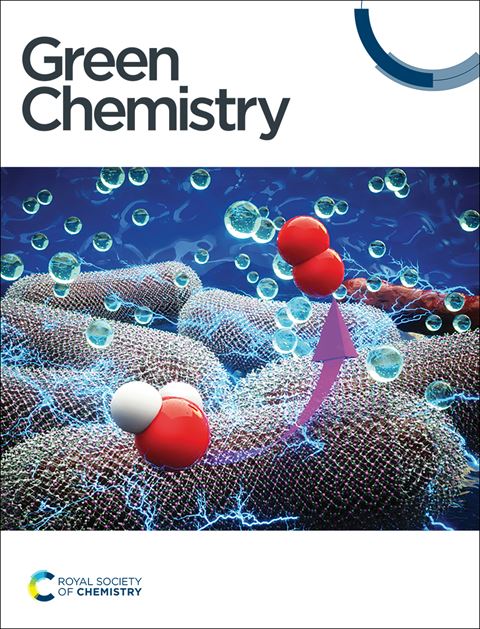生物聚氨酯生产技术经济与环境综合评价
IF 9.3
1区 化学
Q1 CHEMISTRY, MULTIDISCIPLINARY
引用次数: 0
摘要
聚氨酯(PU)是消耗最多的材料之一,通常由化石基多元醇和多异氰酸酯生产。在这种情况下,增加PU生物碳含量是一种提高其可持续性的策略,例如,通过使用生物多元醇和生物多异氰酸酯。生物基五亚甲基聚异氰酸酯(PDI-T)是一种用于生产生物pu的预聚体,其生物碳含量为70%。然而,其生产路线尚未被广泛报道。因此,本文对蓖麻油和PDI-T制备新型生物pu凝胶的工艺进行了理论研究。设计了以糖蜜为原料生物制备PDI-T的工艺。采用过程建模与仿真、成本估算、经济分析和生命周期评价(LCA)等方法,对生产的生物pu的技术经济和环境性能进行了综合评价。该工艺表明,糖蜜到pu的产量为0.2 tbio-PU糖蜜−1,经济可行性达到每吨1.5万美元的销售价格,即比传统pu凝胶的价格高出5倍。从摇篮到大门的LCA显示,每千克生物PU的全球变暖潜能值(GWP)为22.8千克二氧化碳当量,比Ecoinvent数据库中报告的传统PU的GWP高4倍。该方法可以确定对全球升温潜能值和生产成本产生负面影响的关键限制,主要是生物pdi - t合成的复杂性,涉及高能耗和多种原材料的累积排放。这项研究强调,用高生物碳替代品替代化石基成分并不总是能带来气候效益。因此,应用这种方法对于确定真正可持续的途径或建议对现有过程进行修改,以实现有效的绿色化学过渡至关重要。本文章由计算机程序翻译,如有差异,请以英文原文为准。
Integrated technoeconomic and environmental assessment of biogenic polyurethane production†
Polyurethane (PU), one of the most consumed materials, is conventionally produced from fossil-based polyols and polyisocyanates. In this case, increasing the PU biogenic carbon content is a strategy followed to enhance its sustainability, e.g., by employing bio-polyols and biogenic polyisocyanates. Bio-based pentamethylene polyisocyanate (PDI-T), with 70% biogenic carbon content, is a prepolymer commercialized for bio-PU production. However, its production route has not yet been widely reported. Thus, herein, a theoretical study was conducted to investigate the manufacturing process of a novel bio-PU gel using castor oil and PDI-T. The biogenic production of PDI-T from molasses was designed. A comprehensive assessment integrating process modelling and simulation, cost estimation, economic analysis, and life-cycle assessment (LCA) methodologies was performed to evaluate the techno-economic and environmental performance of the produced bio-PU. This process showed a molasses-to-PU yield of 0.2 tbio-PU tmolasses−1, with the economic viability reaching a selling price of $15 000 per ton, i.e., five-times higher than the price of a conventional PU-gel. Cradle-to-gate LCA showed a global warming potential (GWP) of 22.8 kg CO2e per kg bio-PU, which is four-times higher than the GWP reported in the Ecoinvent database for conventional PU. This methodology allowed the identification of key limitations negatively impacting GWP and production costs, primarily the complexity of bio-PDI-T synthesis, which involves high energy consumption and cumulative emissions from multiple raw materials. This study highlights that substituting fossil-based components with high biogenic carbon alternatives does not always result in climate benefits. Therefore, applying this methodology is pivotal for identifying truly sustainable pathways or suggesting modifications to existing processes, to achieve effective green chemistry transition.
求助全文
通过发布文献求助,成功后即可免费获取论文全文。
去求助
来源期刊

Green Chemistry
化学-化学综合
CiteScore
16.10
自引率
7.10%
发文量
677
审稿时长
1.4 months
期刊介绍:
Green Chemistry is a journal that provides a unique forum for the publication of innovative research on the development of alternative green and sustainable technologies. The scope of Green Chemistry is based on the definition proposed by Anastas and Warner (Green Chemistry: Theory and Practice, P T Anastas and J C Warner, Oxford University Press, Oxford, 1998), which defines green chemistry as the utilisation of a set of principles that reduces or eliminates the use or generation of hazardous substances in the design, manufacture and application of chemical products. Green Chemistry aims to reduce the environmental impact of the chemical enterprise by developing a technology base that is inherently non-toxic to living things and the environment. The journal welcomes submissions on all aspects of research relating to this endeavor and publishes original and significant cutting-edge research that is likely to be of wide general appeal. For a work to be published, it must present a significant advance in green chemistry, including a comparison with existing methods and a demonstration of advantages over those methods.
 求助内容:
求助内容: 应助结果提醒方式:
应助结果提醒方式:


